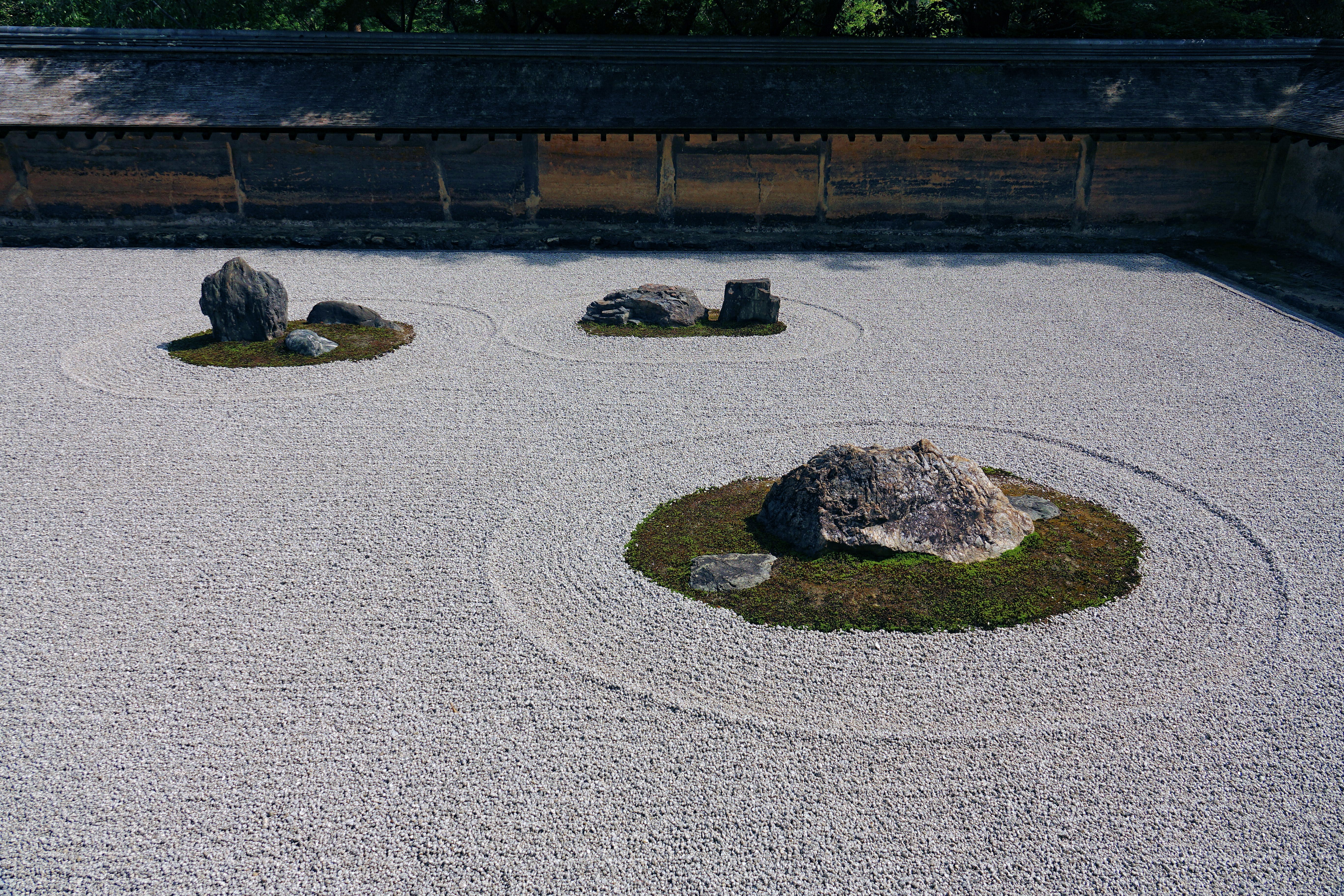|
Bonshō
, also known as or are large bells found in Buddhist temples throughout Japan, used to summon the monks to prayer and to demarcate periods of time. Rather than containing a clapper, are struck from the outside, using either a handheld mallet or a beam suspended on ropes. The bells are usually made from bronze, using a form of expendable mould casting. They are typically augmented and ornamented with a variety of bosses, raised bands and inscriptions. The earliest of these bells in Japan date to around 600 CE, although the general design is of much earlier Chinese origin and shares some of the features seen in ancient Chinese bells. The bells' penetrating and pervasive tone carries over considerable distances, which led to their use as signals, timekeepers and alarms. In addition, the sound of the bell is thought to have supernatural properties; it is believed, for example, that it can be heard in the underworld. The spiritual significance of means that they play an im ... [...More Info...] [...Related Items...] OR: [Wikipedia] [Google] [Baidu] |
Bell (instrument)
A bell is a directly struck idiophone percussion instrument. Most bells have the shape of a hollow cup that when struck vibrates in a single strong strike tone, with its sides forming an efficient resonator. The strike may be made by an internal "clapper" or "uvula", an external hammer, or—in small bells—by a small loose sphere enclosed within the body of the bell (jingle bell). Bells are usually cast from bell metal (a type of bronze) for its resonant properties, but can also be made from other hard materials. This depends on the function. Some small bells such as ornamental bells or cowbells can be made from cast or pressed metal, glass or ceramic, but large bells such as a church, clock and tower bells are normally cast from bell metal. Bells intended to be heard over a wide area can range from a single bell hung in a turret or bell-gable, to a musical ensemble such as an English ring of bells, a carillon or a Russian zvon which are tuned to a common scale and instal ... [...More Info...] [...Related Items...] OR: [Wikipedia] [Google] [Baidu] |
Ryōan-ji
Ryōan-ji ( ja, 竜安寺, label=Shinjitai, ja, 龍安寺, label=Kyūjitai, ''The Temple of the Dragon at Peace'') is a Zen temple located in northwest Kyoto, Japan. It belongs to the Myōshin-ji school of the Rinzai branch of Zen Buddhism. The Ryōan-ji garden is considered one of the finest surviving examples of ''kare-sansui'' ("dry landscape"), a refined type of Japanese Zen temple garden design generally featuring distinctive larger rock formations arranged amidst a sweep of smooth pebbles (small, carefully selected polished river rocks) raked into linear patterns that facilitate meditation. The temple and its gardens are listed as one of the Historic Monuments of Ancient Kyoto, and as a UNESCO World Heritage Site. History The site of the temple was an estate of the Fujiwara clan in the 11th century. The first temple, the ''Daiju-in'', and the still existing large pond were built in that century by Fujiwara Saneyoshi. In 1450, Hosokawa Katsumoto, another powerful warlord, ... [...More Info...] [...Related Items...] OR: [Wikipedia] [Google] [Baidu] |
Japanese New Year
The is an annual festival with its own customs. Since 1873, the official Japanese New Year has been celebrated according to the Gregorian calendar, on January 1 of each year, . However, some traditional events of the Japanese New Year are partially celebrated on the first day of the year on the modern Tenpō calendar, the last official lunisolar calendar which was used until 1872 in Japan. History Prior to the Meiji period, the date of the Japanese New Year had been based on Japanese versions of lunisolar calendar (the last of which was the Tenpō calendar) and, prior to Jōkyō calendar, the Chinese version. However, in 1873, five years after the Meiji Restoration, Japan adopted the Gregorian calendar and the first day of January became the official and cultural New Year's Day in Japan. Traditional food The Japanese eat a selection of dishes during the New Year celebration called , typically shortened to ''osechi.'' Many of these dishes are sweet, sour, or dried, so the ... [...More Info...] [...Related Items...] OR: [Wikipedia] [Google] [Baidu] |
Sutra
''Sutra'' ( sa, सूत्र, translit=sūtra, translit-std=IAST, translation=string, thread)Monier Williams, ''Sanskrit English Dictionary'', Oxford University Press, Entry fo''sutra'' page 1241 in Indian literary traditions refers to an aphorism or a collection of aphorisms in the form of a manual or, more broadly, a condensed manual or text. Sutras are a genre of ancient and medieval Indian texts found in Hinduism, Buddhism and Jainism. In Hinduism, sutras are a distinct type of literary composition, a compilation of short aphoristic statements.Gavin Flood (1996), ''An Introduction to Hinduism'', Cambridge University Press, , pages 54–55 Each sutra is any short rule, like a theorem distilled into few words or syllables, around which teachings of ritual, philosophy, grammar, or any field of knowledge can be woven. The oldest sutras of Hinduism are found in the Brahmana and Aranyaka layers of the Vedas. Every school of Hindu philosophy, Vedic guides for rites of passage, v ... [...More Info...] [...Related Items...] OR: [Wikipedia] [Google] [Baidu] |
Strickle
Dry measures are units of volume to measure bulk commodities that are not fluids and that were typically shipped and sold in standardized containers such as barrels. They have largely been replaced by the units used for measuring volumes in the metric system and liquid volumes in the imperial system but are still used for some commodities in the US customary system. They were or are typically used in agriculture, agronomy, and commodity markets to measure grain, dried beans, dried and fresh produce, and some seafood. They were formerly used for many other foods, such as salt pork and salted fish, and for industrial commodities such as coal, cement, and lime. The names are often the same as for the units used to measure liquids, despite representing different volumes. The larger volumes of the dry measures apparently arose because they were based on heaped rather than "struck" (leveled) containers. Today, many units nominally of dry measure have become standardized as units of mas ... [...More Info...] [...Related Items...] OR: [Wikipedia] [Google] [Baidu] |
Nara Period
The of the history of Japan covers the years from CE 710 to 794. Empress Genmei established the capital of Heijō-kyō (present-day Nara). Except for a five-year period (740–745), when the capital was briefly moved again, it remained the capital of Japanese civilization until Emperor Kanmu established a new capital, Nagaoka-kyō, in 784, before moving to Heian-kyō, modern Kyoto, a decade later in 794. Japanese society during this period was predominantly agricultural and centered on village life. Most of the villagers followed Shintō, a religion based on the worship of natural and ancestral spirits named ''kami.'' The capital at Nara was modeled after Chang'an, the capital city of the Tang dynasty. In many other ways, the Japanese upper classes patterned themselves after the Chinese, including adopting the Chinese writing system, Chinese fashion, and a Chinese version of Buddhism. Literature Concentrated efforts by the imperial court to record its history produced the ... [...More Info...] [...Related Items...] OR: [Wikipedia] [Google] [Baidu] |
Goguryeo
Goguryeo (37 BC–668 AD) ( ) also called Goryeo (), was a Korean kingdom located in the northern and central parts of the Korean Peninsula and the southern and central parts of Northeast China. At its peak of power, Goguryeo controlled most of the Korean peninsula, large parts of Manchuria and parts of eastern Mongolia and Inner Mongolia. Along with Baekje and Silla, Goguryeo was one of the Three Kingdoms of Korea. It was an active participant in the power struggle for control of the Korean peninsula and was also associated with the foreign affairs of neighboring polities in China and Japan. The ''Samguk sagi'', a 12th-century text from Goryeo, indicates that Goguryeo was founded in 37 BC by Jumong (), a prince from Buyeo, who was enthroned as Dongmyeong. Goguryeo was one of the great powers in East Asia, until its defeat by a Silla–Tang alliance in 668 after prolonged exhaustion and internal strife caused by the death of Yeon Gaesomun (). After its fall, its territory w ... [...More Info...] [...Related Items...] OR: [Wikipedia] [Google] [Baidu] |
Ōtomo No Satehiko
Ōtomo no Satehiko (大伴挾手彦) was a Japanese general. Sadehiko was the son of Ōtomo no Kanamura. He twice led forces against the Korean kingdom of Goguryeo, first in 537 CE (some sources claim 536) and later in 562. A legend regarding his first campaign tells of how his wife, Matsura Sayohime, climbed to the hills above Hizen was an old province of Japan in the area of the Saga and Nagasaki prefectures. It was sometimes called , with Higo Province. Hizen bordered on the provinces of Chikuzen and Chikugo. The province was included in Saikaidō. It did not inclu ... and prayed with such intensity for his safe return that she was turned into stone. References Japanese soldiers People of Kofun-period Japan {{Japan-mil-bio-stub ... [...More Info...] [...Related Items...] OR: [Wikipedia] [Google] [Baidu] |
Bianzhong
Bianzhong (Chinese:编钟) is an ancient Chinese musical instrument consisting of a set of bronze bells, played melodically. China is the earliest country to manufacture and use musical chimes. They are also called Chime Bells. These sets of chime bells were used as polyphonic musical instruments and some of these bells have been dated at between 2,000 to 3,600 years old. They were hung in a wooden frame and struck with a mallet. Using a wooden hammer and a rod to beat the bronze bell can make different pitch. Along with the stone chimes called ''bianqing'', they were an important instrument in China's ritual and court music going back to ancient times. Several sets of ''bianzhong'' were imported to the Korean court during the Song Dynasty. Pronounced in Korean as pyeonjong, the instrument became an important part in Korea's ritual and court music and is still in use. In Vietnam, the instrument, which was used in ceremonies in the court at Huế, is called biên chung. The instr ... [...More Info...] [...Related Items...] OR: [Wikipedia] [Google] [Baidu] |






